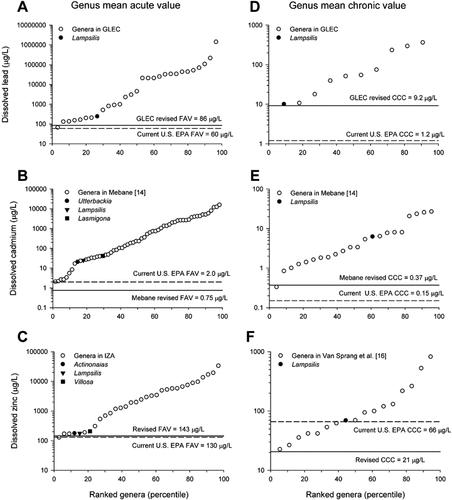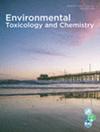Sensitivity of early life stages of freshwater mussels (Unionidae) to acute and chronic toxicity of lead, cadmium, and zinc in water
IF 3.6
4区 环境科学与生态学
Q2 ENVIRONMENTAL SCIENCES
Ning Wang, Christopher G. Ingersoll, Christopher D. Ivey, Douglas K. Hardesty, Thomas W. May, Tom Augspurger, Andy D. Roberts, Eric van Genderen, M. Chris Barnhart
下载PDF
{"title":"Sensitivity of early life stages of freshwater mussels (Unionidae) to acute and chronic toxicity of lead, cadmium, and zinc in water","authors":"Ning Wang, Christopher G. Ingersoll, Christopher D. Ivey, Douglas K. Hardesty, Thomas W. May, Tom Augspurger, Andy D. Roberts, Eric van Genderen, M. Chris Barnhart","doi":"10.1002/etc.250","DOIUrl":null,"url":null,"abstract":"<p>Toxicity of lead, cadmium, or zinc to early life stages of freshwater mussels (fatmucket, <i>Lampsilis siliquoidea</i>; Neosho mucket, <i>L. rafinesqueana</i>) was evaluated in 48-h exposures with mussel larvae (glochidia), in 96-h exposures with newly transformed (5-d-old) and two- or six-month-old juvenile mussels, or in 28-d exposures with two- or four-month-old mussels in reconstituted soft water. The 24-h median effect concentrations (EC50s) for fatmucket glochidia (>299 µg Pb/L, >227 µg Cd/L, 2,685 µg Zn/L) and 96-h EC50s for two- or six-month-old fatmucket (>426 µg Pb/L, 199 µg Cd/L, 1,700 µg Zn/L) were much higher than 96-h EC50s for newly transformed fatmucket (142 and 298 µg Pb/L, 16 µg Cd/L, 151 and 175 µg Zn/L) and Neosho mucket (188 µg Pb/L, 20 µg Cd/L, 145 µg Zn/L). Chronic values for fatmucket were 10 µg Pb/L, 6.0 µg Cd/L, and 63 and 68 µg Zn/L. When mussel data from the present study and the literature were included in updated databases for deriving U.S. Environmental Protection Agency water quality criteria, mussel genus mean acute values were in the lower percentiles of the sensitivity distribution of all freshwater species for Pb (the 26th percentile), Cd (the 15th to 29th percentile), or Zn (the 12th to 21st percentile). The mussel (<i>Lampsilis</i>) genus mean chronic value was the lowest value ever reported for Pb (the 9th percentile) but was near the middle of the sensitivity distribution for Cd (the 61st percentile) or Zn (the 44th percentile). These results indicate that mussels were relatively sensitive to the acute toxicity of these three metals and to the chronic toxicity of Pb, but were moderately sensitive to the chronic toxicity of Cd or Zn compared to other freshwater species. Environ. Toxicol. Chem. 2010;29:2053–2063. © 2010 SETAC</p>","PeriodicalId":11793,"journal":{"name":"Environmental Toxicology and Chemistry","volume":"29 9","pages":"2053-2063"},"PeriodicalIF":3.6000,"publicationDate":"2010-08-04","publicationTypes":"Journal Article","fieldsOfStudy":null,"isOpenAccess":false,"openAccessPdf":"https://sci-hub-pdf.com/10.1002/etc.250","citationCount":"79","resultStr":null,"platform":"Semanticscholar","paperid":null,"PeriodicalName":"Environmental Toxicology and Chemistry","FirstCategoryId":"93","ListUrlMain":"https://onlinelibrary.wiley.com/doi/10.1002/etc.250","RegionNum":4,"RegionCategory":"环境科学与生态学","ArticlePicture":[],"TitleCN":null,"AbstractTextCN":null,"PMCID":null,"EPubDate":"","PubModel":"","JCR":"Q2","JCRName":"ENVIRONMENTAL SCIENCES","Score":null,"Total":0}
引用次数: 79
引用
批量引用
Abstract
Toxicity of lead, cadmium, or zinc to early life stages of freshwater mussels (fatmucket, Lampsilis siliquoidea ; Neosho mucket, L. rafinesqueana ) was evaluated in 48-h exposures with mussel larvae (glochidia), in 96-h exposures with newly transformed (5-d-old) and two- or six-month-old juvenile mussels, or in 28-d exposures with two- or four-month-old mussels in reconstituted soft water. The 24-h median effect concentrations (EC50s) for fatmucket glochidia (>299 µg Pb/L, >227 µg Cd/L, 2,685 µg Zn/L) and 96-h EC50s for two- or six-month-old fatmucket (>426 µg Pb/L, 199 µg Cd/L, 1,700 µg Zn/L) were much higher than 96-h EC50s for newly transformed fatmucket (142 and 298 µg Pb/L, 16 µg Cd/L, 151 and 175 µg Zn/L) and Neosho mucket (188 µg Pb/L, 20 µg Cd/L, 145 µg Zn/L). Chronic values for fatmucket were 10 µg Pb/L, 6.0 µg Cd/L, and 63 and 68 µg Zn/L. When mussel data from the present study and the literature were included in updated databases for deriving U.S. Environmental Protection Agency water quality criteria, mussel genus mean acute values were in the lower percentiles of the sensitivity distribution of all freshwater species for Pb (the 26th percentile), Cd (the 15th to 29th percentile), or Zn (the 12th to 21st percentile). The mussel (Lampsilis ) genus mean chronic value was the lowest value ever reported for Pb (the 9th percentile) but was near the middle of the sensitivity distribution for Cd (the 61st percentile) or Zn (the 44th percentile). These results indicate that mussels were relatively sensitive to the acute toxicity of these three metals and to the chronic toxicity of Pb, but were moderately sensitive to the chronic toxicity of Cd or Zn compared to other freshwater species. Environ. Toxicol. Chem. 2010;29:2053–2063. © 2010 SETAC
淡水贻贝(Unionidae)生命早期对水中铅、镉和锌的急性和慢性毒性的敏感性
铅、镉或锌对淡水贻贝早期生命阶段的毒性(fatmucket, Lampsilis siliquoidea;在48小时暴露于贻贝幼虫(glochidia), 96小时暴露于新转化(5天大)和2或6个月大的幼年贻贝,或28天暴露于2或4个月大的再造软水贻贝中,对Neosho mucket, L. rafinesqueana)进行了评估。脂肪mucket glochidia的24 h中位效应浓度(EC50s) (>299µg Pb/L, >227µg Cd/L, 2685µg Zn/L)和2个月或6个月脂肪mucket的96 h EC50s (>426µg Pb/L, 199µg Cd/L, 1,700µg Zn/L)远高于新转化脂肪mucket的96 h EC50s(142和298µg Pb/L, 16µg Cd/L, 151和175µg Zn/L)和Neosho mucket(188µg Pb/L, 20µg Cd/L, 145µg Zn/L)。脂肪市场的慢性值为10µg Pb/L, 6.0µg Cd/L, 63µg Zn/L和68µg Zn/L。当将本研究的贻贝数据和文献纳入美国环境保护局水质标准的更新数据库时,贻贝属的平均急性值在所有淡水物种对Pb(第26百分位),Cd(第15至29百分位)或Zn(第12至21百分位)的敏感性分布中处于较低的百分位。贻贝(lamsilis)属平均慢性值是有史以来报道的Pb(第9百分位)的最低值,但对Cd(第61百分位)和Zn(第44百分位)的敏感性分布接近中间。结果表明,与其他淡水物种相比,贻贝对这三种金属的急性毒性和Pb的慢性毒性相对敏感,对Cd和Zn的慢性毒性中等敏感。环绕。Toxicol。化学2010;29:2053 - 2063。©2010 setac
本文章由计算机程序翻译,如有差异,请以英文原文为准。
来源期刊
期刊介绍:
The Society of Environmental Toxicology and Chemistry (SETAC) publishes two journals: Environmental Toxicology and Chemistry (ET&C) and Integrated Environmental Assessment and Management (IEAM). Environmental Toxicology and Chemistry is dedicated to furthering scientific knowledge and disseminating information on environmental toxicology and chemistry, including the application of these sciences to risk assessment.[...]
Environmental Toxicology and Chemistry is interdisciplinary in scope and integrates the fields of environmental toxicology; environmental, analytical, and molecular chemistry; ecology; physiology; biochemistry; microbiology; genetics; genomics; environmental engineering; chemical, environmental, and biological modeling; epidemiology; and earth sciences. ET&C seeks to publish papers describing original experimental or theoretical work that significantly advances understanding in the area of environmental toxicology, environmental chemistry and hazard/risk assessment. Emphasis is given to papers that enhance capabilities for the prediction, measurement, and assessment of the fate and effects of chemicals in the environment, rather than simply providing additional data. The scientific impact of papers is judged in terms of the breadth and depth of the findings and the expected influence on existing or future scientific practice. Methodological papers must make clear not only how the work differs from existing practice, but the significance of these differences to the field. Site-based research or monitoring must have regional or global implications beyond the particular site, such as evaluating processes, mechanisms, or theory under a natural environmental setting.


 求助内容:
求助内容: 应助结果提醒方式:
应助结果提醒方式:


